Launch, 24 November 2022
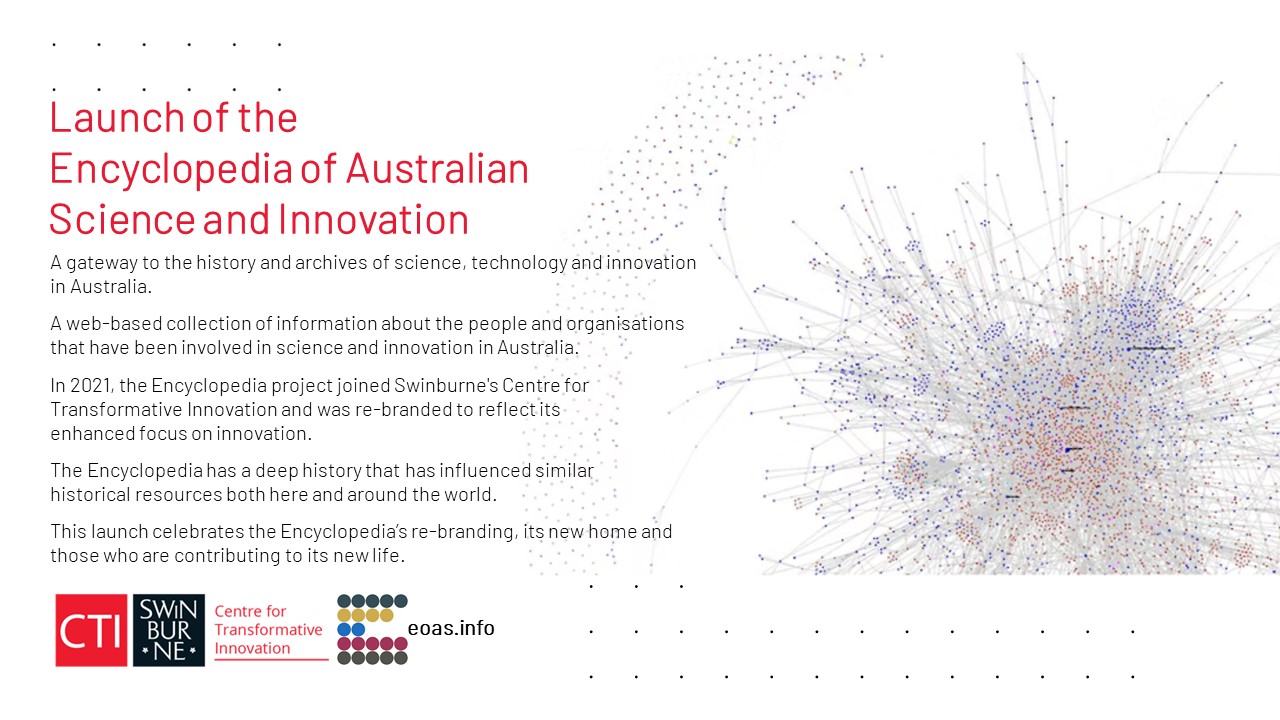
The Centre for Transformative Innovation at Swinburne University of Technology launched the Encyclopedia of Australian Science and Innovation at 6.00pm on the 24th November 2022 in the AGSE202 Lecture Theatre. Our guest speaker was The Honourable Barry Jones AC FAA FTSE FAHA FASSA. This record of the event, in the order of speaking, includes the scripts or transcripts of the speakers' presentations.
Professor Tom Spurling: Welcome and housekeeping remarks.
Acknowledgement to Country: “We respectfully acknowledge the Traditional Custodians of the land on which we gather, the Wurundjeri people of the Kulin Nation. We also pay respects to all Aboriginal Community Elders, past and present, who have resided in the area and have been an integral part of the history of this region.”
Professor Tom Spurling: Introduces and invites the Encyclopedia’s Editor-in-Chief, Associate Professor Gavan McCarthy to the lectern.
Gavan McCarthy, an archivist, was, in 1985, the first member of staff of the Australian Science Archives Project in the Department of History and Philosophy of Science at the University of Melbourne. This was led by Professor Rod Home who I am pleased to welcome here tonight. ASAP eventually became the eScholarship Research Centre and Gavan was its Director until it was closed in 2020. He is known internationally for his innovative approach to archival description and contextual information management. In 2021 he joined the Centre for Transformative Innovation at Swinburne University of Technology as an honorary research fellow and resumed his role as Editor-in-Chief of the Encyclopedia of Australian Science and Innovation.
Associate Professor Gavan McCarthy:
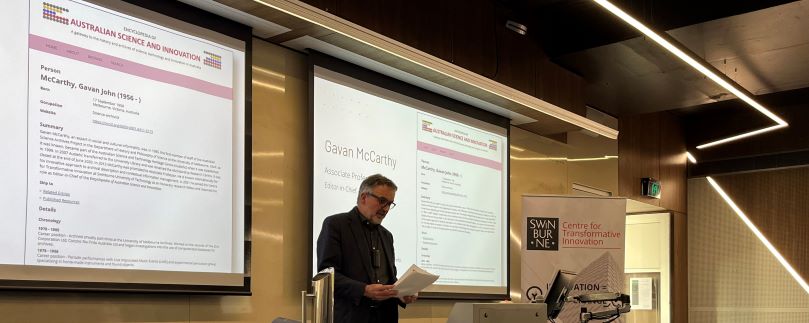
In November 1962, 60 years ago this month, the Australian Journal of Science published an article modestly titled: “A Check List of Publications on the History of Australian Science”. It had been prepared by a 36 year old Research Associate at the “Basser Library of the History of Australian Science”, Australian Academy of Science, and the History Department of the Research School of Social Sciences, the Australian National University. Her name was Ann Mozley (later Moyal)
We think this was the first attempt at a general bibliography of the history of Australian science, that is, a service to aid research. It probably should be recognized as the earliest common ancestor of the Encyclopedia of Australian Science and Innovation – being launched today. The Encyclopedia, is a service to the community, a gateway, a bridge, a living archive, and a repository of knowledge for future generations. Globally, this type of apparatus can be traced back to 1912 and one of the founders of ‘history of science’, George Sarton, in his vision for a journal that included an annual bibliography.
The 1962 publication covered 9 dense journal pages. It included 321 references divided into emergent groupings that still make sense today. The biography and institutions groups were further subdivided by names of people and organisations: 88 people were featured as were 8 institutions. Most of the people, all male, were from the biological sciences and the institutions were mostly museums and royal societies.
Today, the Encyclopedia, with just the odd exception, includes all the references in the 1962 article but, rather than just 321, it has well over 23,000 bibliographic references. [645 Australian Journal of Science pages]. It also has entries for nearly 6,400 people, 3,000 institutions or organisations, as well as entries of other types of entity. In total, the data comprises over 2.1 million structured, standards-based data elements, from ‘dates of birth’ to brief narratives. The data can be expressed in different forms but what we are launching today is the web version comprising over 35,000 findable and citable individual pages. But the Encyclopedia is more than just a bibliography, it also includes references to archival collections, museum collections, patents and datasets. Critically, it includes structured biographical, organizational and similar entries that link everything together and provide extended contexts for interpretation. New editions are published 4 times a year.
The Encyclopedia is a community-driven and a volunteer-curated enterprise. This endeavour has always relied on institutional support, with the Swinburne University of Technology joining the Australian Academy of Science and the University of Melbourne in that collective. Every now and then project funding has been found to add significant data and evolve the data model and database tools. These funders have included the Australian Research Council, state and federal governments, philanthropy and individuals. Many people have contributed to the Encyclopedia since its beginnings in 1985 but the following played pivotal roles: Rod Home; Bert Bolton; Tim Sherratt; Joanne Evans; Ailie Smith; and most recently, Tom Spurling.
New comers to the Encyclopedia invariably find gaps or amendments that they would like to see addressed. While it is not possible to be “comprehensive”, it remains an enduring vision. We tend to prioritise new entries where public knowledge is at a high risk of being lost. Contemporary scientists with a strong public web presence drop down our pending list. For example, the remarkable mathematician, Terence Tao, originally from WA. He will get an entry, eventually. This year we have been tackling the many awards and prizes for scientists in Australia, the details of which, in many cases, are in danger of being forgotten.
The quickly evolving digital world offers opportunities and challenges. We were on the Internet in 1990, on the web in 1994, and have been adapting our practices to add to, rather than duplicate, the information discovery infrastructure developed by others. As it happens, the Encyclopedia is genuinely unique in Australia and has been a model for the development of similar online services around the world, most notably the Isis Cumulative Bibliography published by the History of Science Society, the University of Chicago and the University of Oklahoma under the banner IsisCB Explore. Professor Stephen Weldon runs that program and is a friend, colleague and a member of our Editorial Advisory Committee. We are presently in the process of realising a dream of systemically linking the two services.
Buried within the Encyclopedia is information about Australian First Nations’ knowledge and the intergenerational mechanisms by which it is sustained, tested, verified and the way it evolves over time. From our Indigenous colleagues comes the concept of the “living archive” built on relational social and cultural informatics. These are our shared foundations. We are working with First Nations communities and leaders to find the bridges and connections between these different but not incommensurate ways of knowing. Our vision is a gateway that will meet the needs of all Australians in the 21st Century.
Lastly, I would like to thank our current curation team: Helen Cohn, Ken McInnes and Helen Wolff. They put in many hours every week improving the quality and consistency of the data, filling gaps and linking up entries. Their commitment and passion is unsurpassed.
In November 1962, I was 6 years old and at primary school on Yorta Yorta country in Yarrawonga; Rod Home was teaching physics at Haileybury College after graduating for the University of Melbourne; Tom Spurling was completing his studies in physical chemistry at the University of Western Australia; Barry Jones was teaching at Dandenong High School; and we believe Karen Hapgood, the Deputy Vice-Chancellor Research here at Swinburne, was yet to be born. These little gems were gleaned from the Encyclopedia. Thank You.
Professor Tom Spurling: Introduction of Barry Jones
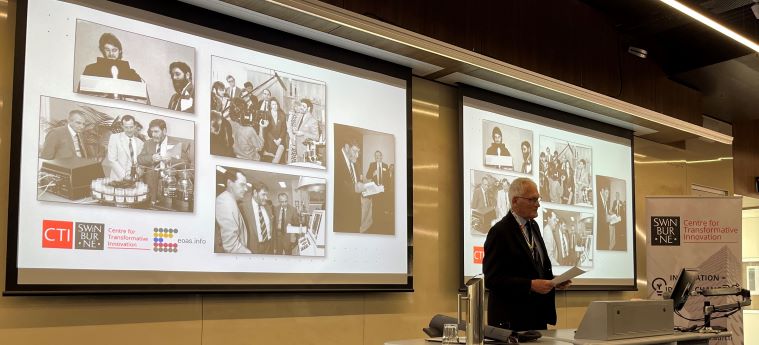
"It a great pleasure for me to welcome the Honourable Barry Jones AC to launch the Swinburne edition of the Encyclopedia with its new name, the Encyclopedia of Australian Science and Innovation.
There is no-one more appropriate to launch the Encyclopedia of Australian Science and Innovation. His book, ‘Sleepers, Wake! : Technology and the Future of Work’ was published in 1982 and was highly influential. Barry became the Minister for Science in the Hawke Government in 1983 and remained in that role until 1990. He is our longest serving Minister for Science, although Richard Casey was the Minister in Charge of CSIRO from 1950 to 1960.
As Minister for Science he was the architect of the modernisation of our national innovation system. CSIRO was restructured with a Board, an independent Chair and a Chief Executive, the Cooperative Research Centres were introduced as one of many ways of increasing collaboration across the system. A Chief Scientist was appointed, reporting to the Prime Minister, to elevate science and innovation in the national debate. The Australia Prize (now the PM Science and Innovation Prizes) was introduced.
This is of course not the first time that you have been to Swinburne. We believe this is your fifth official visit. As Minister for Science you visited Swinburne in:
1985 – to award the AAV Australia Scholarship to then third year Swinburne Film and TV student, Matthew Fine1988 – officially opened the Swinburne Science Shop
1989 – officially launched the National Scientific Instrumentation Centre (NSIC) at the then Swinburne Institute of Technology
1992 – Launched John Legge's book The competitive edge: How Innovation Creates and Sustains the Competitive Advantage of Enterprises
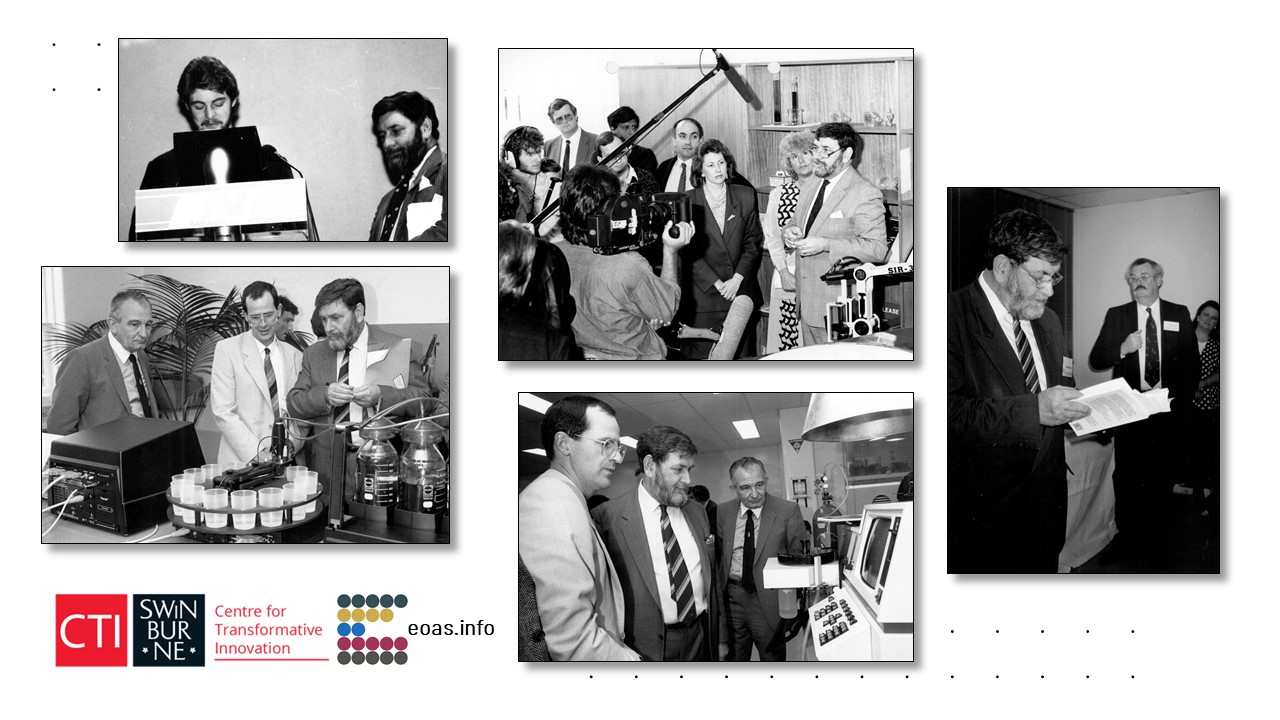
So 30 years later we look forward to hearing your remarks and I invite you to come forward. Ladies and gentlemen, the Honourable Barry Jones."
The Honourable Barry Jones AC FAA FTSE FAHA FASSA:
Introduction
I was honoured when Tom Spurling invited me to launch this important work, an exceptionally interesting and important research archive about the contribution of Australia to science and innovation. The timing of this launch is significant, when Australia is at the crossroads, still hesitant about which direction to pursue.
We live in a post-truth era
The IT revolution has had unexpected and unwelcome results, especially fake news and IT as a vector of misinformation - e.g. Twitter. Australia is a highly sophisticated urban society, but it is dependent on high-volume exports of raw materials—usually the characteristic of third-world or developing economies. And this is not an accident. It is planned that way. Governments encourage it, and investors give their highest priority to mining and property.
Australia’s spectacular failure to develop elaborately transformed manufactures has inevitably led to an over-reliance on fossil fuels for our export income, adding to the risk of irreversible climate change. Of our ten major export earners, all but two are raw materials or concentrates (iron, coal, natural gas, gold, aluminium, beef, petroleum, and copper). The only exceptions—foreign tourists and overseas students—came due to Covid.
The criticism that Donald Horne made in The Lucky Country in 1964 that we think of Australia as a quarry and a farm still has some validity, almost 60 years on: Where would we be if we only had the resources of Israel, Sweden, or Finland? Harvard University’s Center for International Development publishes an authoritative Atlas of Economic Complexity, based on the premise that ‘Economic development requires the accumulation of productive knowledge and its use in both more and more complex industries ... Countries improve their Economic Complexity Index (ECI) by increasing the number and complexity of the products they successfully export.’
ECI rankings 1995 2020: Australia 55 91 | Japan 1 1; Switzerland 4 2; South Korea 21 3; Germany 3 4; Singapore 20 5; Sweden 3 8; United States 9 12; Finland 5 14; United Kingdom 7 10; Italy 10 16; France 8 18; China 46 17; Israel 19 21; Canada 22 43; India 60 46; Brazil 25 60; Vietnam 107 52; New Zealand 33 53; Indonesia 76 67.
Because Australia has chosen to be primarily an exporter of high-volume raw materials and refuses to seize the opportunities arising from transitioning to a post-carbon economy, which would create highly sophisticated export industries, our ECI is falling. We have the skill to reverse this, but I am not sure if we have the will. The good news for Australia is that we are still ahead of Ethiopia and Papua-New Guinea.
Government support for STEM (Science, Technology, Engineering, and Mathematics) disciplines is welcome, but there is no overarching plan to develop new industries capable of driving the transition to a post-carbon economy. Indeed, until May 2022 government rhetoric harked back to the 1980s.
How the Digital Revolution Changed Everything
If every citizen has the potential to master the universe through a device in her/ his hand we might reasonably expect an unprecedented level of informed public discourse and a determination to solve the great challenges to civilization, our habitat and the planet itself. It has not worked out this way.
An unexpected result of providing low cost access to the big, wide world has been the rise of populism and identity politics, in which expertise is dismissed or derided. Far from a heralding a new Renaissance or Age of Enlightenment, the transition from computers > Internet > World Wide Web > has had a down side > ‘confirmation bias’ > ‘cherry picking’ of information > Donald Trump > Narendra Modi > Boris Johnson > Scott Morrison > Jair Bolsanaro > Rodrigo Duterte > Silvio Berlusconi > the revival of religious fundamentalism > the cult of the personal > exponential increases in gambling, drug use, conspicuous consumption and obesity > racism and suspicion of ‘the Other’ > a distinct anti-science bias.
If anything, recent decades have been marked by the fragmentation of knowledge, linked to individual experience and short term needs. Now every user can be her/ his own expert and seek the variety of truth that best suits them.
The Great Political Crossover
Education levels and cultural affinities rather than income and economic security are becoming the major determinants of how people vote, and whether they define themselves as progressive or conservative.
The French economist Thomas Piketty in his very important book Capitalism and Ideology (Harvard, 2020) analysed voting patterns in the United States, the United Kingdom, France and Australia. For decades the poor voted for radicals and the affluent and aspirational voted conservative. Now this is changing. In the UK in 2015 many of the poorest electorates voted to leave the European Union, of which they knew little, while the most affluent and productive voted to remain. In the US in 2020, Donald Trump won an overwhelming majority of the poorest counties and Joe Biden won the best educated and most affluent.
Australia’s most significant social, economic, cultural and political division is not longer between the traditional political parties but between graduates v. non graduates, at present about a 50/50 split among voters. This has been roughly characterised as ‘globals v. locals’ or ‘anywheres’ (people confident of their mobile professional skills) v. ‘somewheres’ (people looking for security with the familiar.)
Tertiary educated professionals, many with high incomes, such as surgeons in Malvern, are becoming radicalised. Blue collar workers, especially self-employed tradies, carpenters in Ringwood, are becoming more conservative.
The same sex marriage plebiscite in 2017 was a striking indicator of this radical/ conservative crossover. Kooyong had a ‘Yes’ vote of 73.7% (with 86% participation) and Blaxland (Paul Keating’s old seat) of only 26.1% (with 75% participation.) Of the 17 seats with a ‘No’ majority, eleven were very safe for the ALP.
In the US, Donald Trump was extraordinarily effective in harvesting the rage of angry white males. This had several elements: the disappearance of many traditional work forms, the threat to patriarchy by feminist activism, the speed of technological change. Elites were attacked as condescending for using evidence, statistics, expertise to tell people how they should live, including eating, drinking, gambling, entertainment, what vehicles they should drive, waste disposal, having greater respect for women and girls, restricting gun ownership, and how they understood and interpreted the world. There was also ‘dog whistling’ on race, refugees and ‘the Other’ generally.
Trump had some impact in Australia – essentially on the fringes, with angry, alienated voters, perhaps up to 10 percent. But in a close election contest, that 10 per cent can be decisive. Opinion and feeling has become more powerful than evidence and experience, witness the powerful reaction by anti-vaxxers and climate change denialists. Reliance on social media as the principal source of information creates an ‘echo chamber’ effect, with a unique capacity to spread misinformation, unchallenged.
The Federal election of 21 May 2022 did more than bring about a change in government with the defeat of the Coalition, it challenged the duopoly of the two major hegemonic parties, which are both under threat. They have become inward looking, faction ridden and resentful of criticism.
The most encouraging sign is that professionally qualified people who used to be disengaged and voted with pegs on their noses, are now playing an active role – recognising that existing hegemonic parties have a very small, moribund, faction driven, membership.
Voters proved to be more interested in the destination than the vehicle and put far more emphasis on seeking solutions to ‘wicked problems’, such as climate change, corruption and integrity, gender issues, foreign policy and national identity. The issue of securing an adequate taxation base for the long term was evaded.
On climate change, the combination of ALP, Greens, teal and rust independents secured more than 60 per cent support for effective action and destroyed the veto power of the National Party, with 6.2 per cent of the national vote.
‘Freedom’ and Secrecy
‘Freedom’ has been used as a rallying cry by dissenters who rage against the concept that political, economic and social decisions ought be based on evidence, analysis and reasoned debate, and assert that private judgment, essentially based on feeling and opinion should have priority. Laws, regulations or court decisions based on evidence or expertise are rejected as elitist, repressive and denying basic personal liberty, the freedom to insist that 2+2 = 5.
Freedom to deny the reality and threat of climate change. Freedom to deny that that Covid exists and to reject vaccines, masks and social distancing, freedom to infect others, to promote fake remedies. Freedom to abuse people, face to face or through social media, on the basis of gender, sexuality, language, race, culture.
Freedom to choose one’s own reality (for example to reject US election results), to propagate one’s own facts. As Daniel Patrick Moynihan insisted: ‘Everyone is entitled to her opinion, but not to her own facts’. Freedom to ignore the needs of others. Freedom to lie, to make stuff up, not to be accountable.
In recent years the only way to get a straight answer to a question has been through a ICAC/IBAC, Royal Commission or the courts. Parliament, newspapers, journals, television, radio, public debate? Forget them.
Australia is the most secretive of all Western democracies – far more so than the US or UK. The appalling secret trial – now called off – of Bernard Collaery could never have happened in Washington or London. It was not for threatening national security but for causing national embarrassment and humiliation for exposing the appalling behaviour of a previous government in spying on a friendly state to profit an Australian company. Collaery was not allowed to know all the charges against him and even now he is forbidden to answer certain questions about the case.
Involvement in war is entirely secret in Australia – unlike the US, UK or Canada where the legislature is involved. But not here. There are subjects we just don’t talk about – gambling, junk food, obesity, racism, increasing inequality. But we are opening up about domestic violence, suicide and mental health.
We are starting to talk more honestly about our history and the proposed referendum on ‘the Voice to Parliament’ is extremely important. It is possible that the total number of Indigenes killed in massacres and frontier wars is about equivalent to the deaths of Australian service personal in World Wars I and II, in Korea, Vietnam and Afghanistan.
A modest suggestion
I know this is probably against the rules of the game but I think that the ‘People’ section, likely to be the most consulted part of the Encyclopedia, should be regarded as a ‘work in progress’ and needs a great deal of TLC. I’d like to help if I can. I started by reading three entries, not quite at random.
My own entry – of forbidding length – has a number of slips or omissions. (AC described as Officer; two Fellowships missing, Dictionary of World Biography, with heavy scientific emphasis, National – not Federal – President of ALP, Trinity College, Cambridge, G7 Summit, The Ozone Layer Conference, London, Sleepers, Wake! is lacking a comma. But the most important gap is no reference to my work on climate change, post-industrialism, the IT revolution and stem cells.
Hubert Jarvis (1882- ). English born entomologist in Queensland. That would make him 140 years old – implausible. After a few minutes of Googling I found his year of death (1964) – and that he was a very competent painter, well represented in the Queensland Art Gallery. He also had extensive publications on moths and birds.
Julian Tenison-Woods - Catholic priest and amateur geologist - no reference to his important discovery of extinct megafauna in the Naracoorte Caves (now a World Heritage site) or to his working relationship with St Mary McKillop. [Ed. These may have already been addressed]
I wish the whole enterprise well.
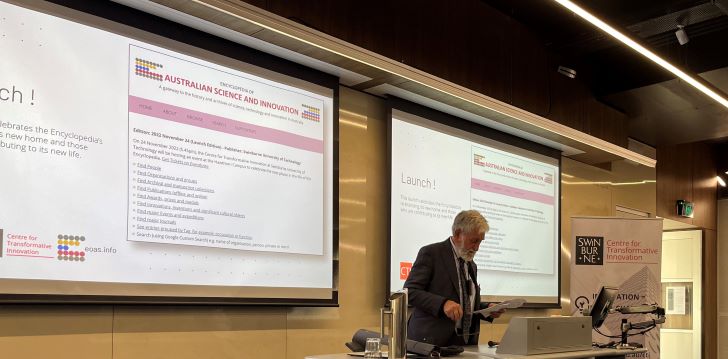
Professor Karen Hapgood, Deputy Vice-Chancellor Research, Swinburne University of Technology: Vote of Thanks
It is my great pleasure to have been here tonight and hear Barry Jones’ wide ranging speech. I especially enjoyed his reminiscences on the Hawke government. It was absolutely worth the detour. It was a lovely evening. I am very pleased to be at this event because I knew of this encyclopedia long before this event. As noted earlier by Gavan I am of a slightly younger generation of the Australian scientists and engineers.
I have used this Encyclopedia for exactly the reason you said, for finding information that was lost to my contemporaries. I was involved in presenting the chemical engineering ‘Clive Pratt Award’ and asked, ‘who is 'Clive Pratt'?’ A colleague forwarded me the Encyclopedia entry, which was the only place with the answer. I was able to share this with the recipients.
Another important entry is Bronwyn Adams. She is the first female chemical engineer to graduate in Victoria. She graduated from Monash University in 1971. Again, the only place you could find any information about her was in this particular encyclopedia. And there are many, many more examples. As you said, Barry, its value is to keep that collective knowledge of our history that can’t be found anywhere else on the internet.
And certainly, Barry Jones you had a front seat for much of this history and have been a very active player. So, I would really like to thank Barry for coming and being part of our event tonight. To thank him very much and we have a gift to present to Barry. Thank you..
Professor Tom Spurling: Closes the event and invites guests to a cocktail reception downstairs.
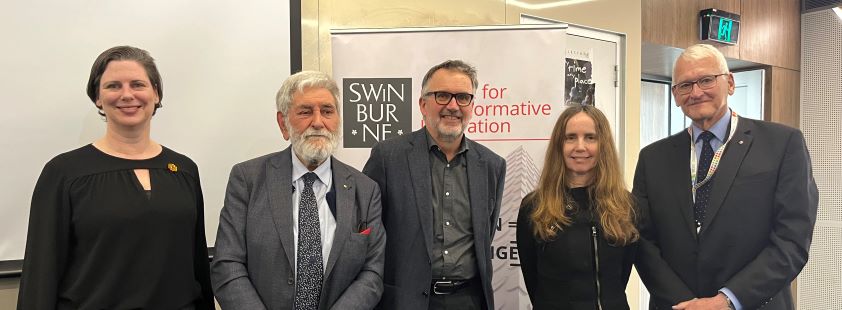
The speakers (from the left: Karen Hapgood, Barry Jones, Gavan McCarthy and Tom Spurling) with Professor Beth Webster, Director of the Centre for Transformative Innovation, Swinburne University of Technology (second from right).
Credits: Photographs - Helen Wolff; PowerPoint images - Ken McInnes and Helen Wolff; Page construction: Gavan McCarthy
